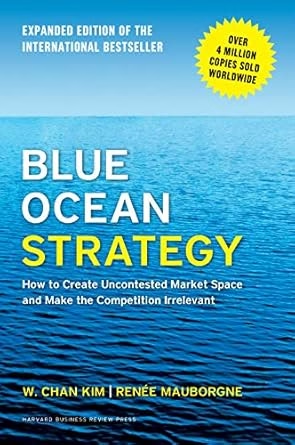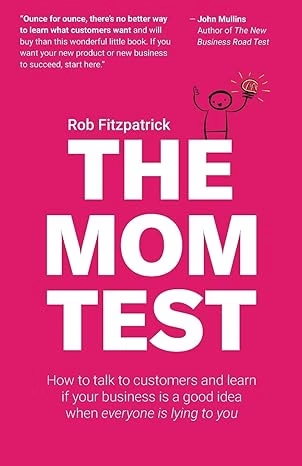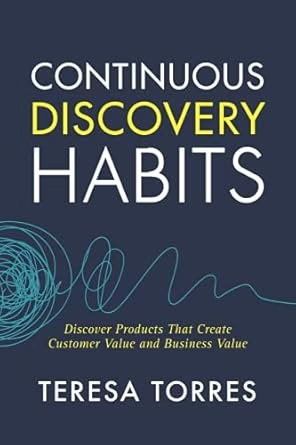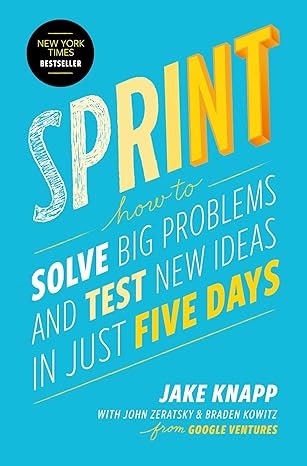Product management requires a blend of strategic thinking, customer insights, data-driven decision-making, and execution skills. Whether you’re an aspiring product manager or a seasoned professional, reading the right books can enhance your capability. They can help you to discover, build, and launch great products.
Here’s a list of essential books with the best product management ideas from the top thought leaders, categorized by the NBM4 structure.
1. Solution Discovery
1.1 Idea: Generating and Identifying Great Product Ideas

The Innovator’s Dilemma by Clayton Christensen
- Examines why successful companies fail and how disruptive innovation impacts product strategy.
- Essential reading for those looking to anticipate market shifts and technology disruptions.
Clayton Christensen‘s “The Innovator’s Dilemma” is a highly influential business book. It explores why successful companies often fail to maintain market leadership despite doing everything right. Christensen introduces the concept of disruptive innovation, explaining how established companies can be overtaken by new, disruptive technologies or business models.
The book provides a framework for understanding and capitalizing on disruptive innovation, using examples of both successful and failed attempts by leading companies. It emphasizes the need for managers to recognize when and how to abandon traditional practices to embrace new opportunities. This book is considered essential reading for managers, leaders, and entrepreneurs seeking to navigate the challenges of innovation.

Inspired: How to Create Products Customers Love by Marty Cagan
- Introduces the role of vision-driven product management and how to create products that customers truly love.
- Stresses the importance of empowered product teams and rapid experimentation.
“Inspired” by Marty Cagan focuses on the distinct product development methods used by leading tech companies. It aims to teach these techniques, primarily to Product Managers working on technology-driven products, across various industries and company sizes. The book covers a wide range of products, from consumer apps to enterprise solutions.
Additionally, “Inspired” caters to designers, engineers, user researchers, and data scientists who collaborate with Product Managers. It provides insights into the collaborative processes that drive successful product creation within these innovative companies.

Blue Ocean Strategy by W. Chan Kim & Renée Mauborgne
- Shows how companies can identify untapped markets instead of competing in saturated ones.
- Uses frameworks like Value Innovation to create differentiated products.
“Blue Ocean Strategy” by W. Chan Kim & Renée Mauborgne is a global bestseller, translated into 49 languages. It challenges traditional strategy, arguing competition leads to a “red ocean.” The book advocates creating “blue oceans,” untapped markets for growth. It offers tools to make competition irrelevant, based on 150 strategic moves.
The updated edition includes new content, addressing reader questions and providing current examples. It guides readers in creating uncontested market space and achieving strategic success. Additional resources and teaching materials are available at https://www.blueoceanstrategy.com/teaching-materials/.

The Four Steps to the Epiphany by Steve Blank
- Introduces the Customer Development Process as a framework for startups to discover and validate business models.
- Emphasizes iterative learning and adapting to customer feedback rather than following a rigid business plan.
“The Four Steps to the Epiphany” presents a foundational approach to building successful startups by focusing on customer discovery and iterative learning. Steve Blank challenges the traditional notion of startups as smaller versions of large companies. Instead, he defines them as organizations in search of a repeatable and scalable business model.
This methodology prioritizes early customer validation, encouraging entrepreneurs to test assumptions before scaling. The book introduces the Customer Development model, which consists of four key phases:
- Customer Discovery – Identifying real customer needs.
- Customer Validation – Ensuring a product solves a validated problem.
- Customer Creation – Scaling customer acquisition effectively.
- Company Building – Transitioning to a structured business organization.
By applying these principles, startups can avoid premature scaling and costly failures. The book serves as a practical guide for entrepreneurs, product managers, and investors, providing a scientific approach to launching successful businesses in an uncertain market.

The Lean Startup by Eric Ries
- Introduces the Build-Measure-Learn feedback loop to validate ideas quickly.
- Encourages launching an MVP (Minimum Viable Product) to test assumptions before heavy investment.
“The Lean Startup” presents a globally recognized method to reduce startup failure rates. It defines startups as organizations navigating extreme uncertainty to create new products or businesses, regardless of size or team experience. The core mission is to discover a sustainable business model through this uncertainty.
This approach emphasizes efficient resource utilization and creative problem-solving, drawing from lean manufacturing principles. It promotes validated learning through rapid experimentation and customer feedback, enabling agile adjustments and shorter product development cycles. Instead of rigid business plans, it encourages continuous testing and adaptation, offering a scientific framework for managing startups in an era demanding constant innovation.

The Startup Owner’s Manual by Steve Blank & Bob Dorf
- Guides startups on customer discovery and validation through iterative experimentation.
- Guides the Customer Development Process to refine product-market fit.
“The Startup Owner’s Manual” provides detailed instructions for building successful startups. It’s used by entrepreneurs, the NSF, and top universities globally. Steve Blank’s Customer Development method, first introduced in the “The Four Steps to the Epiphany,” a basis of the “Lean Startup,” is outlined.
The 608-page guide includes charts, checklists, and diagrams for profitability. It helps avoid startup failures and use the Business Model Canvas. The book also teaches how to identify and acquire customers for scalable profits.
1.2 Customer: Understanding Customer Needs and Market Segments

The Mom Test by Rob Fitzpatrick
- Provides a framework for conducting effective customer interviews that yield actionable insights.
- Teaches how to ask unbiased questions to validate product demand.
“The Mom Test” by Rob Fitzpatrick provides practical advice for customer conversations in startups. It advises against asking people if a business idea is good, as they may lie.
The book emphasizes finding the truth yourself through effective customer interactions. It focuses on avoiding common mistakes in customer conversations. It aims to improve skills for Customer Development and Lean Startup practices.

Jobs to Be Done: Theory to Practice by Anthony Ulwick
- Focuses on why customers hire products to solve specific problems.
- Introduces the Outcome-Driven Innovation (ODI) framework for better product development.
Anthony Ulwick pioneered innovation processes since 1990, addressing why projects fail. He introduced Jobs to be Done (JTBD) theory to Clayton Christensen in 1999. Ulwick’s company, Strategyn, has an 86% success rate applying this theory. Philip Kotler calls Ulwick the “Deming of Innovation,” turning it into a science.
The book covers avoiding innovation failures and using the Jobs to be Done Needs Framework. It details growth strategies, outcome-based segmentation, and Outcome-Driven Innovation. It also explains the “language” of Jobs to be Done.

Continuous Discovery Habits by Teresa Torres
- Teaches ongoing customer research methods to make better product decisions.
- Encourages frequent touchpoints with customers to improve iteration speed.
This book teaches a structured approach to continuous product discovery. It helps ensure products meet customer needs and create business value. It balances action and doubt, allowing for confident progress and adaptation. Teresa Torres, an experienced coach, provides the guidance. She has taught discovery skills to thousands of product professionals.
The book emphasizes incorporating customer input into daily product decisions. It’s praised for making customer engagement a continuous and effective habit. It helps teams shift from outputs to outcome focused development.

User Story Mapping by Jeff Patton
- Helps product teams visualize customer journeys and structure features accordingly.
- Introduces story mapping as a technique to align teams around customer-centric development.
User story mapping helps software teams focus on users and needs. Jeff Patton’s book explains how to use this technique effectively. Story maps facilitate better conversations throughout the development process. Teams gain a shared understanding of project goals and purpose.
The book provides a quick overview of story mapping concepts. It explains how stories function in Agile and Lean projects. It covers the story lifecycle, from opportunity to discovery. It guides teams in preparing, building, and learning from stories.
1.3 Value Suggestion: Defining and Articulating Value Propositions

Monetizing Innovation by Madhavan Ramanujam & Georg Tacke
- Discusses how to price products based on customer value rather than cost.
- Introduces pricing strategies that align with willingness to pay.
“Monetizing Innovation” challenges the conventional approach to innovation, arguing that most companies fail to effectively monetize their new products. It attributes this failure to a lack of focus on customer demand and willingness to pay, advocating for a shift towards designing products around price. The authors, from Simon Kucher, a leading pricing consultancy, provide a nine-step approach based on their extensive experience with global clients.
The book offers a practical framework to move from hoping to monetize to knowing you will, emphasizing data-driven decision-making over the “spray and pray” method. It includes case studies from successful companies like LinkedIn and Uber, demonstrating how to integrate monetization principles into the innovation process. This guide is designed for leaders and product development teams seeking to improve their success rate. These teams aim to avoid the billions lost annually due to failed innovations.

Value Proposition Design by Alexander Osterwalder
- Helps teams craft compelling value propositions using the Value Proposition Canvas.
- Provides practical frameworks for testing and refining business models.
Alexander Osterwalder is an author of the Business Model Canvas. “Value Proposition Design” provides a practical approach to creating products customers want. Building upon “Business Model Generation,” it introduces the “Value Proposition Canvas” for designing, testing, and managing compelling offerings. This book helps avoid product failures by understanding customer needs and desires, offering a structured process for developing successful value propositions.
It includes an online companion with tools and resources for assessment and learning. The book is essential for anyone seeking a proven method to create value propositions that sell, applicable to startups and large corporations alike. It emphasizes aligning products with customer needs to build profitable business models.
2. Solution Delivery
2.1 Value Test: Validating Assumptions and Product-Market Fit

The Lean Product Playbook by Dan Olsen
- Provides a step-by-step approach for defining and testing product hypotheses.
- Introduces the Problem-Solution Fit and Product-Market Fit concepts.
“The Lean Product Playbook” provides a practical guide for building successful products using Lean Startup principles. It addresses the challenge of applying Lean thinking effectively, offering a step-by-step methodology called the Lean Product Process. This playbook helps teams identify target customers, uncover underserved needs, and create effective product strategies.
It guides users through defining an MVP, designing prototypes, and testing with customers for rapid iteration towards product-market fit. Written by Lean product expert Dan Olsen, it draws from his experience consulting for companies like Facebook and Box. This book is a valuable resource for anyone involved in product development, from entrepreneurs to marketers, seeking to build products customers love.

The North Star Playbook by Amplitude Team
- Focuses on identifying and tracking a North Star Metric that drives product success.
- Helps teams align efforts around data-driven decision-making.
This playbook addresses the common struggle of product teams to achieve clarity, alignment, and accountability, even with diligent effort. It highlights the frustration of product management professionals based on the real life example of Tia. Despite implementing sound product practices, they witnessed their companies struggle with direction and focus. The North Star Framework is presented as a solution. It bridges the gap between customer needs, product features, and business goals, which often operate in silos.
By reading this playbook, you’ll learn to implement the North Star Framework to define a unifying metric. It fosters a shared understanding and drives data-informed decisions. The book provides practical guidance on defining your North Star Metric. It helps in adapting it to your development process. You will learn to facilitate workshops to align your team. The framework aims to eliminate “shiny object” syndrome. It ensures everyone’s work contributes to a sustainable growth strategy. This contribution enables better conversations, improved alignment, and greater impact, as demonstrated by Tia’s success.

Measure What Matters by John Doerr
- Explains how to set Objectives and Key Results (OKRs) to align product and company goals.
- Emphasizes the importance of measuring impact over output.
John Doerr’s “Measure What Matters” introduces Objectives and Key Results (OKRs), a goal-setting system that propelled tech giants like Intel and Google to success. OKRs involve setting clear objectives and measurable key results, fostering transparency and alignment across organizations. Doerr learned about OKRs from Andy Grove at Intel and later shared it with numerous companies, witnessing its effectiveness.
The book showcases how OKRs drive focus, coordination, and trackable progress, linking individual and company-wide goals. Through case studies featuring leaders like Bono and Bill Gates, Doerr illustrates how OKRs enhance agility, growth, and employee satisfaction. This system helps organizations prioritize, measure progress, and achieve ambitious goals, making it essential for leaders seeking to drive significant impact.
2.2 Product: Building the Right Product with the Right Team

High Output Management by Andy Grove
- A guide to efficient product execution and management.
- Provides frameworks for managing product teams and optimizing workflows.
“High Output Management” by Andrew S. Grove offers a practical guide to building and running successful companies. Grove, former Intel CEO, shares his insights on effective management, emphasizing its crucial role in entrepreneurship. The book provides techniques for creating productive teams and motivating peak performance, applicable to various professions beyond just tech.
It serves as a management manifesto, offering real-life business scenario navigation and revolutionary work methods. Grove’s experiences at Intel, from employee number three to CEO, form the basis of his advice. The book is lauded for its valuable advice and observations, making it essential reading for managers and leaders.

Empowered: Ordinary People, Extraordinary Products by Marty Cagan and Chris Jones
- Focuses on how strong leadership empowers product teams to build great products.
- Provides organizational best practices for product-led companies.
Top tech companies like Amazon, Apple, and Google innovate consistently not solely through talent acquisition, but by fostering environments that enable effective collaboration. “EMPOWERED” focuses on how leaders can create such environments, where team members can reach their full potential, as emphasized by Bill Campbell. Marty Cagan and Chris Jones, from Silicon Valley Product Group, provide practical guidance, building on their previous work in “INSPIRED.”
The book distinguishes empowered product teams from typical “feature teams.” It outlines strategies for recruiting, coaching, and motivating teams to achieve competence and reach their potential. It emphasizes creating inspiring product visions, developing insights-driven strategies, and empowering teams to solve problems rather than just build features. “EMPOWERED” also addresses transforming organizational structures to support empowered teams, offering a roadmap for leaders to cultivate innovation and drive success.

Hooked: How to Build Habit-Forming Products by Nir Eyal
- Introduces the Hook Model (Trigger, Action, Variable Reward, Investment) to create addictive products.
- Explains how to build long-term engagement through psychological triggers.
“Hooked” explores how successful companies create habit-forming products that keep users engaged. Nir Eyal introduces the Hook Model, a four-step process used by companies to encourage repeated customer behavior. This method aims to bring users back without relying on extensive advertising.
Based on research and practical experience, the book offers a how-to guide for building products that influence behavior. It provides insights for product managers, designers, and marketers, featuring examples from popular apps and technologies. Readers learn practical steps to create user habits, build engaging products, and understand the psychology behind habit formation.

The Influential Product Manager by Ken Sandy
- Offers a comprehensive overview of core competencies and activities for product managers.
- Covers essential tools and processes, including prioritization, requirements gathering, and trade-off decisions.
“The Influential Product Manager” by Ken Sandy serves as a practical guide for aspiring and new product managers in modern tech companies. It addresses the high demand for product management skills, offering a comprehensive overview of core competencies and activities. The book emphasizes the importance of influence, teaching how to navigate organizational dynamics and drive results without direct authority.
Drawing from extensive industry experience and educational background, the author simplifies complex product management concepts into actionable principles. The book covers essential tools and processes, including prioritization, requirements gathering, and trade-off decisions, all geared towards aligning teams with market needs and organizational goals. Additionally, it provides guidance on career advancement, aiming to ensure both product and personal success.

Sprint by Jake Knapp
- Covers Google Ventures’ proven methodology to test and validate ideas within five days.
- Helps teams rapidly prototype and iterate before committing extensive resources.
“Sprint” introduces the Design Sprint, a five-day process created at Google by Jake Knapp, to rapidly solve tough problems. This method allows teams to quickly prototype and test solutions, gaining customer feedback before significant investment. It helps answer critical business questions about focus, real-world application, and solution validation.
The book provides a step-by-step guide for teams of all sizes to run Design Sprints, replacing traditional, time-consuming meetings with a more efficient and collaborative approach. It empowers teams to quickly progress from problem definition to tested solution, fostering a culture of rapid iteration and informed decision-making across various industries.
2.3 Go to Market: Launching, Scaling, and Monetizing Products

The Product-Led Organization by Todd Olson
- Advocates for product-led growth (PLG) as a strategy for customer acquisition and retention.
- Explains how companies like Slack and Dropbox drive viral product adoption.
Todd Olson is co-founder and CEO of Pendo, the all-in-one product experience platform. He offers a product-led strategy playbook for software teams.
It focuses on building customer experiences around digital products. Product-led organizations use their products for growth and customer retention. The book guides companies in transitioning to this approach. It provides insights for data-driven product decisions and goal setting. It includes playbooks for integrating sales, marketing, and support. It also offers strategies for customer feedback and product roadmaps.

Hacking Growth by Sean Ellis & Morgan Brown
- Covers the data-driven approach to scaling product adoption.
- Introduces growth hacking frameworks used by successful tech companies.
Sean Ellis, founder and CEO of GrowthHackers, the world’s largest community of growth professionals. Morgan Brown is COO of Inman News, the leading business intelligence source for real estate.
“Growth Hacking” details the methodology behind Silicon Valley’s rapid business growth. Companies like Airbnb and Uber used Growth Hacking, not just good products, for success. It’s a method used by startups and large corporations like IBM and Microsoft. Growth Hacking focuses on rapid testing and customer-centric iteration. It aims to acquire, retain, engage, and motivate customers effectively.
The book provides a practical toolkit for creating custom growth hacking strategies. It replaces wasteful approaches with data-driven, replicable results.

The Hard Thing About Hard Things by Ben Horowitz
- Explores the real-world challenges of launching and leading a product-driven company.
- Provides leadership insights on managing uncertainty and scaling teams.
Ben Horowitz is a cofounder of Andreessen Horowitz and one of Silicon Valley’s most respected and experienced entrepreneurs. He gives startup advices, based on his experience and blog. Horowitz addresses tough management issues not taught in business school. He shares insights from developing, managing, and investing in tech companies. He also uses rap lyrics to illustrate business lessons, covering difficult topics.
Filled with his trademark humor and straight talk, this book is invaluable for veteran entrepreneurs as well as those aspiring to their own new ventures, drawing from Horowitz’s personal and often humbling experiences.

Escaping the Build Trap by Melissa Perri
- Helps organizations shift from feature factories to value-driven product teams.
- Explains how to align product development with business goals.
Organizations need customer-centric cultures focused on outcomes, not just outputs. The “build trap” occurs when companies prioritize features over customer needs. Melissa Perri explains how product management solves customer problems and achieves business goals.
Effective communication and collaboration create a beneficial product culture. The book covers scaling product organizations and connecting vision to product activities. It details identifying opportunities and building an outcome-focused culture.
This collection represents a powerful arsenal of insights for any product professional, from foundational principles to cutting-edge strategies. Whether you’re navigating the complexities of startup life, optimizing established product lines, or fostering a culture of innovation, these books offer invaluable guidance.
However, the world of product management is ever-evolving, and new perspectives are constantly emerging. We invite you to contribute to this list by sharing the books that have most inspired your product journey. What hidden gems or recent releases deserve a place on this essential list?
Let us know in the comments below, and subscribe to our newsletter to stay updated.
Works Cited
- Christensen, Clayton. The Innovator’s Dilemma: When New Technologies Cause Great Firms to Fail. Harvard Business Review Press, 2016. https://amzn.to/4ieetnD.
- Cagan, Marty. Inspired: How to Create Products Customers Love. Wiley, 2018. https://amzn.to/4bjJ0ht.
- Kim, W. Chan, and Renée Mauborgne. Blue Ocean Strategy: How to Create Uncontested Market Space and Make the Competition Irrelevant. Harvard Business Review Press, 2015. https://amzn.to/41suXCY.
- Ries, Eric. The Lean Startup: How Today’s Entrepreneurs Use Continuous Innovation to Create Radically Successful Businesses. Crown Business, 2011. https://amzn.to/4hOqvUS.
- Blank, Steve, and Bob Dorf. The Startup Owner’s Manual: The Step-by-Step Guide for Building a Great Company. K&S Ranch, 2012. https://amzn.to/3D3hMPq.
- Fitzpatrick, Rob. The Mom Test: How to Talk to Customers and Learn If Your Business is a Good Idea When Everyone is Lying to You. CreateSpace, 2013. https://amzn.to/4hFSCWd.
- Ulwick, Anthony. Jobs to Be Done: Theory to Practice. Idea Bite Press, 2016. https://amzn.to/4it32sr.
- Torres, Teresa. Continuous Discovery Habits: Discover Products That Create Customer Value and Drive Business Growth. Red Swan, 2021. https://amzn.to/3D1MWqt.
- Patton, Jeff. User Story Mapping: Discover the Whole Story, Build the Right Product. O’Reilly Media, 2014. https://amzn.to/3ERiobB.
- Ramanujam, Madhavan, and Georg Tacke. Monetizing Innovation: How Smart Companies Design the Product Around the Price. Wiley, 2016. https://amzn.to/43qWTbZ.
- Osterwalder, Alexander, et al. Value Proposition Design: How to Create Products and Services Customers Want. Wiley, 2014. https://amzn.to/3QrqFWe.
- Olsen, Dan. The Lean Product Playbook: How to Innovate with Minimum Viable Products and Rapid Customer Feedback. Wiley, 2015. https://amzn.to/4135jDe.
- Amplitude Team. The North Star Playbook: Product-Led Growth Strategies for Winning Products. Amplitude, 2020. https://amplitude.com/books/north-star.
- Doerr, John. Measure What Matters: How Google, Bono, and the Gates Foundation Rock the World with OKRs. Portfolio, 2018. https://amzn.to/3D3OHTZ.
- Grove, Andrew S. High Output Management. Vintage, 1995. https://amzn.to/3DcjmOX.
- Cagan, Marty, and Chris Jones. Empowered: Ordinary People, Extraordinary Products. Wiley, 2020. https://amzn.to/4bbdWk2.
- Eyal, Nir. Hooked: How to Build Habit-Forming Products. Portfolio, 2014. https://amzn.to/4i6DDV2.
- Sandy, Ken. The Influential Product Manager: How to Lead and Launch Successful Technology Products. Berrett-Koehler, 2020. https://amzn.to/438Bioh.
- Knapp, Jake. Sprint: How to Solve Big Problems and Test New Ideas in Just Five Days. Simon & Schuster, 2016. https://amzn.to/3XCpR4X.
- Olson, Todd. The Product-Led Organization: Drive Growth by Putting Product at the Center of Your Customer Experience. Wiley, 2020. https://amzn.to/436eBRA.
- Ellis, Sean, and Morgan Brown. Hacking Growth: How Today’s Fastest-Growing Companies Drive Breakout Success. Currency, 2017. https://amzn.to/4bh7Gaj.
- Horowitz, Ben. The Hard Thing About Hard Things: Building a Business When There Are No Easy Answers. Harper Business, 2014. https://amzn.to/4be0CLI.
- Perri, Melissa. Escaping the Build Trap: How Effective Product Management Creates Real Value. O’Reilly Media, 2018. https://amzn.to/3Xexr5s.
























Leave a Reply